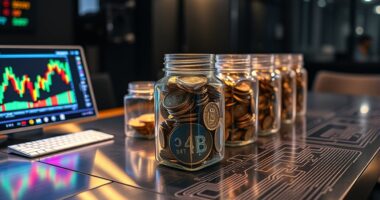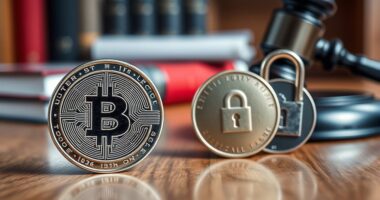Token burn events can seem like a marketing gimmick, but they can also add real value if part of a strategic plan. When done intentionally, burns reduce supply, create scarcity, and potentially boost the token’s value over time. However, if used solely for hype or short-term price spikes, they might not benefit long-term investors. To understand whether a burn truly adds value, it’s important to take into account its context within the project’s overall health and goals.
Key Takeaways
- Token burns can reduce supply and potentially increase value, but their impact depends on execution and underlying project health.
- Some burns are primarily marketing tactics designed to generate hype rather than deliver real long-term benefits.
- Well-planned burns aligned with project growth can enhance ecosystem stability and investor confidence.
- Artificial price spikes from sudden burns may mislead investors without addressing fundamental issues.
- Evaluating a project’s overall health and long-term strategy is essential to determine if burns offer genuine value or are just marketing gimmicks.

Token burn events are deliberate actions where cryptocurrency projects permanently remove a certain amount of tokens from circulation. You might wonder why a project would do this and whether it’s just a marketing stunt or something that genuinely adds value. The main idea behind token burns is to influence the token’s economy by reducing the total supply, which can impact its market value. When tokens are burned, it’s a form of supply reduction, and this can help control inflation within the ecosystem. By decreasing the number of tokens available, projects aim to make the remaining tokens scarcer, potentially boosting their value over time.
Inflation control is a critical aspect of managing a healthy cryptocurrency ecosystem. Just like traditional currencies, cryptocurrencies can face inflation if too many tokens flood the market, diminishing their worth. Token burns act as a countermeasure to this, helping to stabilize or even increase the token’s price by limiting the supply. This supply reduction can create a sense of scarcity, encouraging investors to hold onto their tokens rather than sell them off quickly. As a result, the perceived value of the remaining tokens rises, which can benefit early investors and strengthen the project’s credibility.
However, it’s important to understand that not all token burns are created equal. Some projects burn tokens periodically as part of their economic model, aiming for long-term stability and growth. Others may use burn events as a marketing gimmick to generate hype and attract new investors. While a well-planned burn can genuinely improve the token’s value by controlling inflation and reducing supply, a sudden or overly aggressive burn might simply be a way to manipulate market perception temporarily. This can lead to short-term price spikes that aren’t backed by fundamental improvements, making it seem like a clever move, but potentially masking underlying issues.
In essence, whether a token burn event truly adds value or is just a marketing ploy depends on the context and execution. When executed thoughtfully, it can serve as a strategic tool for inflation control and supply reduction, fostering a healthier, more sustainable ecosystem. But if used solely for hype, it risks misleading investors and creating artificial price movements. As someone interested in cryptocurrencies, you should always look beyond the burn event and assess the project’s overall economic health and long-term prospects. A genuine, well-implemented burn can be a sign of a project committed to stability, but it’s essential to remain cautious and informed about the motives behind each burn.
Understanding inflation control mechanisms is crucial for evaluating the long-term potential of a project, ensuring that burn events align with sustainable growth rather than short-term gains.
Frequently Asked Questions
How Do Token Burns Impact Overall Market Liquidity?
Token burns directly affect market liquidity by reducing the total supply of tokens. When you see a burn impact, less tokens are available for trading, which can increase scarcity and potentially boost value. This decrease in supply can tighten market liquidity, making it more difficult to buy or sell large amounts without affecting the price. Ultimately, token burns can influence market dynamics by shaping liquidity and perceived token value.
Are Token Burns Sustainable Long-Term Strategies?
You wonder if token burns are sustainable long-term strategies. While they create token scarcity, boosting market perception temporarily, relying solely on burns isn’t enough. Over time, the market needs real utility and demand growth for lasting value. Burns can support this, but they shouldn’t replace foundational development. Long-term success depends on balancing burns with innovation, ensuring the market perceives genuine value beyond just reduced supply.
What Are the Legal Implications of Token Burn Events?
You should be aware that token burn events face regulatory challenges and require legal compliance. Authorities may scrutinize whether burns are transparent and align with securities laws, especially if they impact token value or investor interests. Failing to adhere to these regulations could lead to legal consequences, penalties, or damage to your reputation. Ensuring transparency and working with legal experts helps you navigate these legal implications effectively.
How Do Investors Detect Genuine Token Burn Announcements?
You should scrutinize token burn announcements closely to avoid falling for market manipulation, which can skew perceptions of genuine value. Look for transparent details, such as official statements from credible sources and verifiable blockchain data. Investor skepticism is healthy, so verify the burn’s authenticity before reacting. By doing this, you protect yourself from false hype and make certain the burn truly contributes to token scarcity and long-term value.
Can Token Burns Influence Project Development and Innovation?
Token burns can influence project development and innovation by creating token scarcity, which may increase demand and investor confidence. When projects practice transparency about burn events, it reassures you that the process is genuine and beneficial. This trust encourages continued development and innovation, as it aligns project goals with investor interests. However, if burns are used as marketing gimmicks, they might mislead you, ultimately undermining genuine progress.
Conclusion
Token burn events might seem like clever marketing tricks, but they can also genuinely boost value by reducing supply. It’s up to you to evaluate the project’s goals and transparency behind these burns. If done thoughtfully, they can create scarcity and potentially increase prices. However, don’t rely solely on burns—consider the project’s fundamentals. Ultimately, token burns can be beneficial, but only if they’re part of a well-planned strategy that aligns with real growth.









